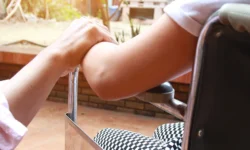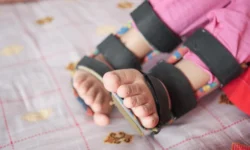Depending on who you ask, you’re likely to get different answers. We’ve compiled the top 10 most misconceptions and myths about Cerebral Palsy here for you!
The information in this post was compiled from government, educational non-profit, and medical expert sources.
Keep reading to learn about the most misunderstood things about Cerebral Palsy.
The Top 10 Most Misunderstood Things About Cerebral Palsy
Without further ado, here are some of the most common misunderstandings about Cerebral Palsy:
1. People with Cerebral Palsy Are Mentally Impaired
Cerebral Palsy is a type of neurological disorder that affects the muscles covers a broad range of symptoms ranging from mild to severe. CP can affect a person’s posture, balance, muscle control, and more–but it is not a form of mental impairment. Approximately half of children with CP do also have some form of mental impairment, however any diagnosis of mental impairment is a separate condition from CP.
2. Cerebral Palsy Can Get Worse Over Time
CP is non-progressive, meaning that it does not get worse over time. Although how a person experiences the symptoms of CP may change over time, especially if a person receives good treatment, the underlying condition itself will not get worse.
3. You Can Get Cerebral Palsy from Your Parents
Cerebral Palsy is most often caused by injuries sustained at or near child birth. One common cause is lack of adequate oxygen at birth. Because Cerebral Palsy is due to injury, it is not a condition that a child can inherit from their parents. This also means that in some cases, CP can be prevented with proper observation and medical care.
4. People with Cerebral Palsy Can’t Go to School
Many programs through the government, non-profits, and private organizations exist to help children with special needs attend school. Although every child has a different journey, many children with CP are able to find accommodations that allow them to attend school. For more information on resources available to help, check out our Resources section.
5. Cerebral Palsy Is Contagious / Is a Disease
False! Cerebral Palsy is not a disease and cannot be transmitted in any form or fashion from one person to another. You can hold and hug and play with a child without risking any kind of transmission of CP to yourself or to the child.
Getting help for a child with HIE or Cerebral Palsy
can make a big difference
Because early intervention is often key to helping improve a child’s wellbeing, it’s important to act swiftly. At the Brown Trial Firm, our Houston birth injury attorneys can help you investigate your case, find answers to your questions, and determine whether you are entitled to compensation. We offer case reviews at no cost or obligation. Many birth injuries that cause cerebral palsy could have been prevented.
6. People with Cerebral Palsy Will not Often Live a Full Life
Although the life expectancy and prognosis of a child with CP can vary greatly, in general, absent other complications, a good prognosis will correlate with a standard life expectancy. Furthermore, good treatment and care can potentially improve a person’s quality of life.
7. Children with Cerebral Palsy Can’t Talk
Only approximately one in four children have speech impairments due to CP. Many children who cannot speak are capable of communicating either through eye-gaze control technology, pictures in books, or through other communication aid devices.
8. People with Cerebral Palsy Can’t Have Relationships
Although conditions can vary, many people with Cerebral Palsy are capable of having relationships. Furthermore, there is no evidence that CP affects fertility or the chances that a woman can conceive.
9. Some Children Outgrow Cerebral Palsy
Unfortunately there is no known cure for Cerebral Palsy. However, with treatment and proper care, many people can improve their experience of the symptoms of Cerebral Palsy. For more information about treatment for CP, read here.
10. Children with Cerebral Palsy Will Never Be Independent
Over half of children with CP can learn to walk independently, and many more can learn to get around independently. Furthermore, with assistive devices, many other physical impairments can be overcome.
Sources:
11 Things to Know about Cerebral Palsy | CDC. (2020). Centers for Disease Control and Prevention. Retrieved 22 April 2020, from https://www.cdc.gov/ncbddd/cp/features/cerebral-palsy-11-things.html
Contact a Cerebral Palsy and Birth Injury Attorney
Getting help for a child with a birth injury can make a big difference. Early intervention and early treatment is often key to helping improve a child’s wellbeing. You must act quickly.
If you have questions about whether your child’s birth injury was caused by a preventable medical error, then our attorneys at Brown Trial Firm may be able to help.
Case Review at No Cost or Obligation
If you would like help investigating your child’s birth injury, please contact us. Our birth injury attorneys will be happy to give you a free case evaluation. We can also point you to great non-legal resources that can help you figure out your next steps.


